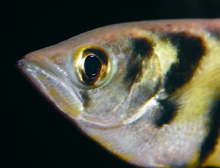Description: Banded archerfish (Toxotes jaculatris) have a deep laterally-compressed body with a flattened head and back. Their dorsal fins, set far back toward the rear of the fish, have four spines. They have large, forward-set, movable eyes and an upward slanting mouth with a long protruding lower jaw that can be thrust out. They are usually a silvery color with four to five vertical black bands on the upper half of the body.
Size: They average 9-10 inches (23-25 cm) in length.
Behavior: Toxotes means “bowman” or “archer,” a name given for their ability to “shoot down” insects and small creatures resting on foliage, floating debris or mangrove roots by expelling beads of water from its mouth. Their flattened body presents a narrow profile from above, so they can sneak up on their prey. The bold black-and-white markings camouflage them in the water under mangrove vegetation. With their tongue against the groove on the roof of their mouth, they form a tube, and force water powerfully out by snapping shut their gills. The fish can squirt up to seven times in quick succession, and the jet can reach 6.6-9.8 feet (2-3 m), but they are accurate to only about 3.3-4.9 feet (1-1.5 m). Fish as small as 0.8-1.2 inches (2-3 cm) long can already spit, but their jets reach only four to eight inches (10-20 cm). Archers usually swim in shooting parties, with several shooting at the same prey.
Diet: The fish gulps it prey in its large, deep, upwardly directed mouth. If the blast doesn’t knock down the prey, sometimes the weight of the water on the wings causes the insect to lose its grip and
fall. These fish can also jump up to 12 inches (30 cm) to catch their prey. They also hunt small aquatic creatures and fishes that are in the water, sometimes swimming in deeper water to catch them.
Senses: For accurate aim of their water stream, they have large eyes located very near the mouth, which give good binocular vision. Their eyes, however, do not automatically correct for refraction, and they have to learn how to do this.
Reproduction: Archerfish become mature at one to two years. They are believed to swim from their brackish water habitats out to coral reefs and coral rocks to spawn. Broadcast spawning is triggered by the rains that end the tropical dry spells. The female lays about 20,000 – 150,000 eggs.
Habitat/range: They can be found in India, New Guinea, Australia, the Philippines, Southeast Asia, and Oceania. Archerfish typically inhabit coastal brackish mangrove estuaries. They exist in either brackish or fresh water. Due to their feeding habits, they are most often found in shallow, preferably murky, waters.
Status: Archerfish have a short life span in the wild (two years). While the majority of archerfish species are fairly common, they are threatened by: rapidly diminishing habitat due to the destruction of mangroves for aquaculture, heavily collected for the aquarium trade and are consumed as part of the human diet in some countries.



